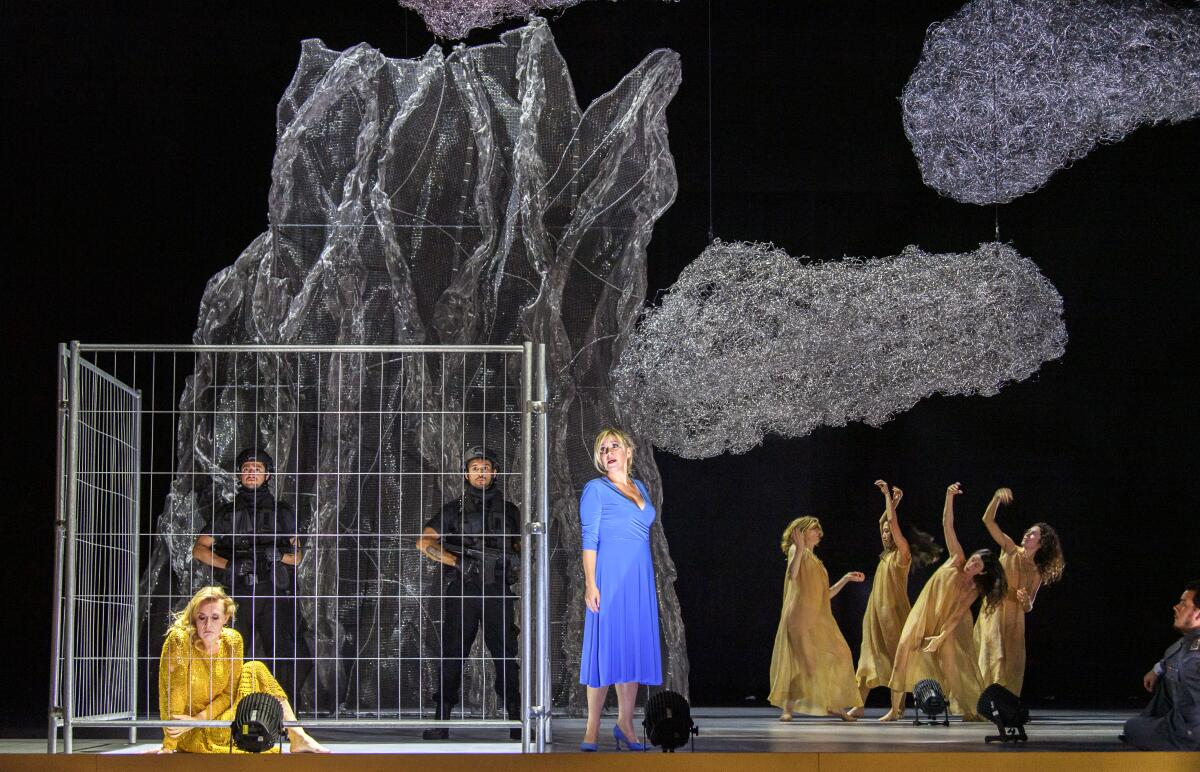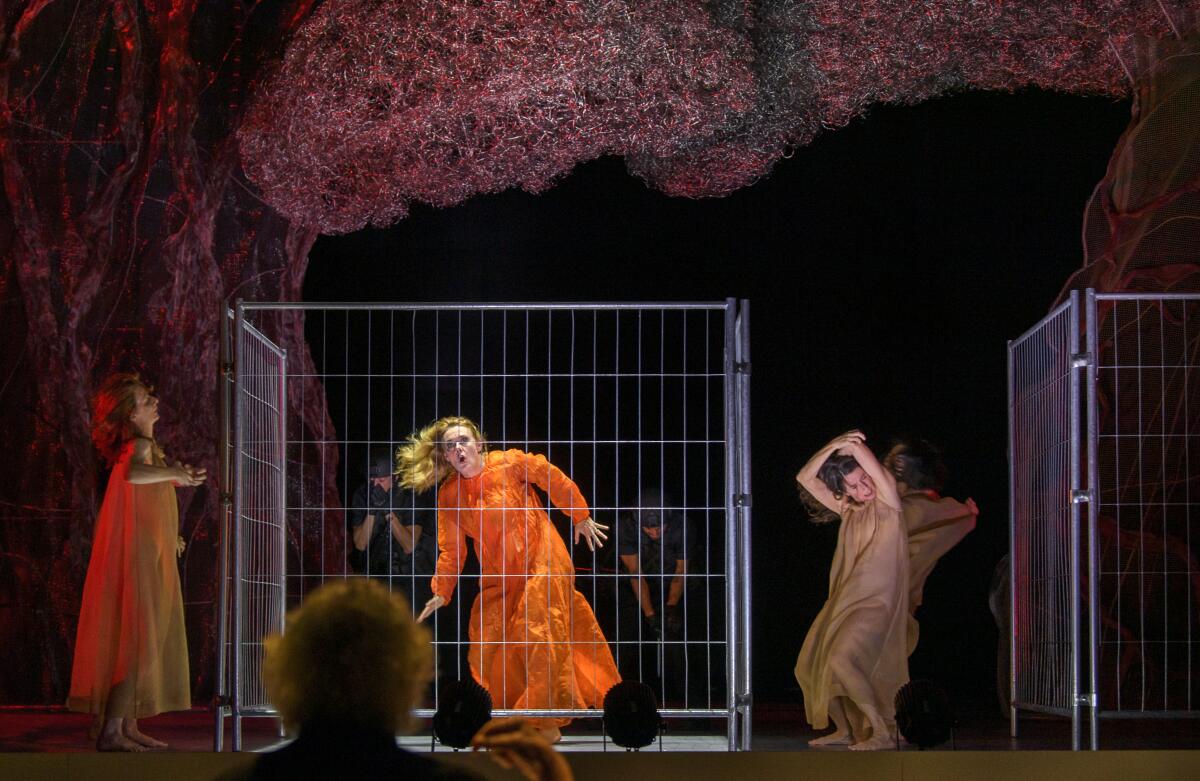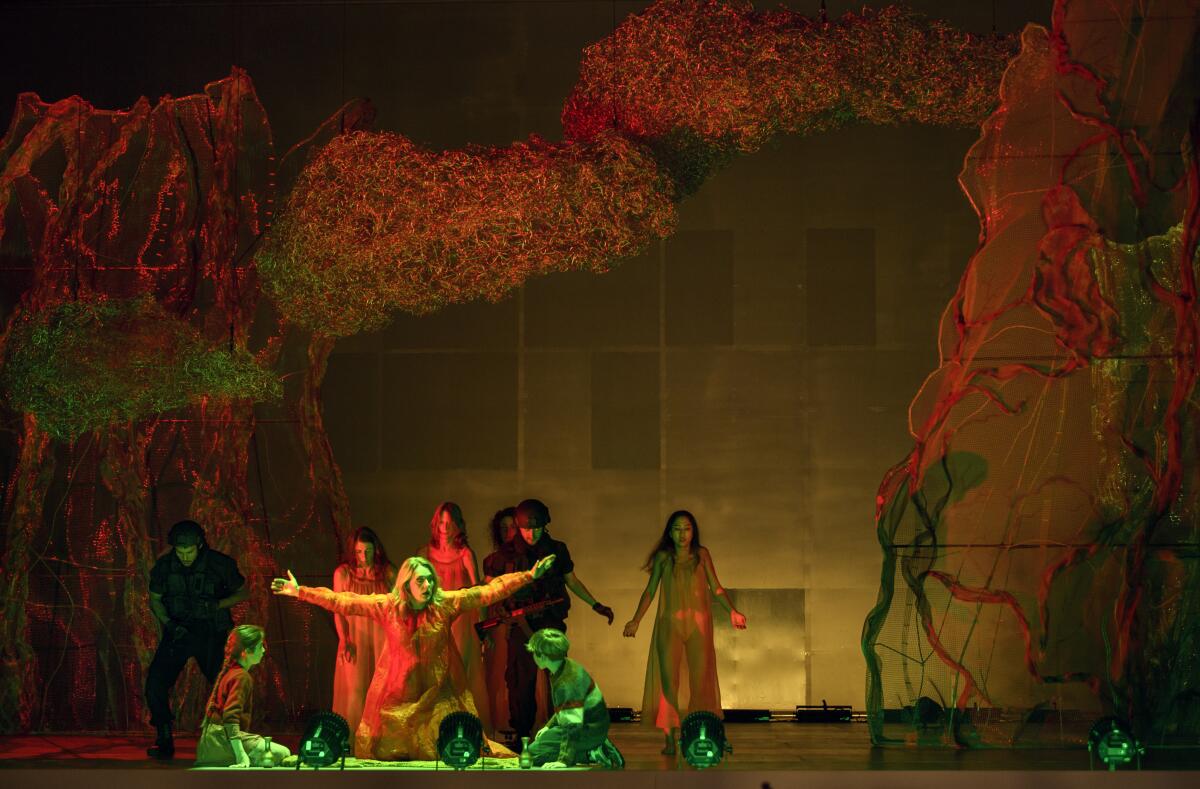One of the greatest operatic performances: How the 1693 ‘Médée’ speaks to the incomprehensible violence of our times

- Share via
BERLIN — For 25 centuries, a mythic Medea has haunted civilization. The sorceress — mortal granddaughter of Helios, the sun god of Greek mythology — kills two of her children as revenge for her husband Jason’s betrayal. How better than through incomprehensible maternal violence to make him suffer? How better to makes us suffer as we contemplate motivations for the violence, the loss of innocent life, troubling our own time?
Euripides first put Medea on the stage in ancient Greece, and she’s never left it. She surrounds us as an iconic figure in literature, film, television, theater, video games and music, both pop and classical. In the new film “May December,” Natalie Portman plays an actor attracted to characters, like Medea, whom she describes as “difficult, on the surface, to understand.”
Last weekend at Walt Disney Concert Hall, Zubin Mehta conducted the Los Angeles Philharmonic in a titanic performance of Mahler’s First Symphony, given in a seldom-heard, five-movement version that the composer initially dubbed “Titan,” after Jean Paul’s epic 19th century German novel. In it, Linda, a character meant to represent the newly emancipated woman, states, “I love Medea more than Creusa,” the latter being the princess for whom Jason leaves Medea.
At Sunday’s performance, I spotted Mehta’s wife, the actor Nancy Kovack, who early in her career happened to star as Medea in the classic 1963 Hollywood film “Jason and the Argonauts,” which also happens to have a terrific score by Bernard Herrmann.
Composers have long been infatuated by Medea’s music charisma. The most direct avenue into her incendiary brew of exalted love and devastating fury, revealing her revelatory voice of emancipation, is opera. One of Maria Callas’ most hair-raising roles was her Medea in Luigi Cherubini’s 1797 opera, which was an influence on Beethoven’s revolutionary “Fidelio,” thus helping usher in the Romantic-era ideal of a woman as liberator.
On what would have been Callas’ 100th birthday, Dec. 2, the Czech mezzo-soprano Magdalena Kozená starred in the last of five performances at the Berlin State Opera of Marc-Antoine Charpentier’s “Médée,” written a century before Cherubini’s opera. This presents a darker, subtler, more shocking Medea. In a gripping production by Peter Sellars, with a set designed by Frank Gehry and an orchestra conducted by Kozená’s husband, Simon Rattle, “Médée” did not so much as raise alarming questions as provide alarming answers. Moment by moment over three hours, we witnessed Medea’s mind in action, how she could reach the point where murdering her children would be emancipation.
It may have helped that I attended the penultimate performance on Nov. 30. I had spent the morning reading belabored obituaries and commentaries of Henry Kissinger in American, British and German newspapers. How to square a brilliant statesman’s ability to negotiate peace with his disregard for human life. Kissinger felt the inevitable fact of history and war is sacrifice. Everything boils down to balance.
This is something we have hardly gotten past. We witness the deaths of innocent children in wars whose intent is liberation. Mass murders in schools have been committed by shooters for whom an AR-15 is a tool of perverted emancipation. But our sorceress has powerful tools of destruction, as well — Medea’s magic.

That a French Baroque opera, written some three centuries before Freud, can so profoundly reveal the internal workings of how such violence can happen may seem a marvel. In fact, the formality of the opera, including the obligatory obsequious prologue in praise of Louis XIV, is what makes “Médée” special.
Formality doesn’t mean formulaic. French opera at the end of the 17th century had not yet become codified with recitatives and arias. It flowed in quick, seamless transitions from one musical or dance form to the next, operating not unlike the mind does. Charpentier himself composed mainly sacred music, glorifying God with ravishing beauty, and that ravishing beauty became his secret weapon in “Médée,” alluring us into openness to all who are before us.
Sellars sets the story as the plight of the immigrant. The warrior Jason has just helped himself to the Golden Fleece aided by Medea’s magic, cunning and fervidness (including killing her brother). He arrives in a kingdom where Medea and her children are held in a detention center, allowing Jason to have an affair with Creuse, the king’s daughter. Medea faces deportation; her children will stay with Jason and Creuse.
Gehry’s set consists of two static diaphanous sculptures that can be anything from ethereally transparent to steely imposing, along with three movable steel wool clouds, all capable of absorbing myriad shades and colors, creating atmosphere, thanks to James F. Ingalls’ brilliant lighting design. Two chain-link cages imprison the refugees.
It is a setting that abstractly reflects the characters’ sentiments and sensations. In the center of it all is Kozená, her each encounter like emotional dominoes that will inevitably fall, as she weighs the worth of her children. Does Jason deserve them? Do they deserve to die lest they become objects of empire, representatives of repression?

Whence compassion? This is where the questions recede. Medea is not morally right, but she has been wronged. In what is surely one of the greatest theatrical and operatic performances of our time, Kozená compels compassion. So do all who do her wrong in a winning cast that included Reinoud Van Mechelen as a clarion Jason and Carolyn Sampson, a sweet-toned Creuse.
Also shocking is that this production — with Rattle’s thrilling conducting of the vibrant period instrument Freiburg Baroque Orchestra — was essentially pop-up opera. There are no plans for a revival. There were no recordings, video or audio; no broadcasts. Being the brilliant brainchild of two essential and famed L.A. artists, the production drew the attendance of a representative of the Los Angeles Philharmonic, where Sellars and Gehry work regularly. But an L.A. “Médée” isn’t likely.
Ironically, though, the first major modern revival of “Médée” inadvertently came about thanks to L.A.’s 1984 Olympic Arts Festival. The centerpiece of the festival was to have been Robert Wilson’s “the CIVIL warS: a tree is best measured when it is down,” a daylong extravaganza at the Shrine Auditorium of new operas created in cities around the world. Funding fell through. But the operas were given individually elsewhere.
One was Gavin Bryars’ hypnotic “Medea.” It was ultimately produced in tandem with Charpentier’s “Médée” in Lyons, France, a few months after the Olympics. Both operas were directed by Wilson. The neglected “Médée” was the first time Wilson had worked on a conventional opera, leading to his becoming one of America’s most important opera directors (and once a regular for L.A. Opera).
It’s not too late for L.A. to make amends. The Olympics will be back in 2028 with presumably another arts festival.
Swed’s columns on classical music will publish every Wednesday, in addition to his occasional reviews and interviews.
More to Read
The biggest entertainment stories
Get our big stories about Hollywood, film, television, music, arts, culture and more right in your inbox as soon as they publish.
You may occasionally receive promotional content from the Los Angeles Times.










